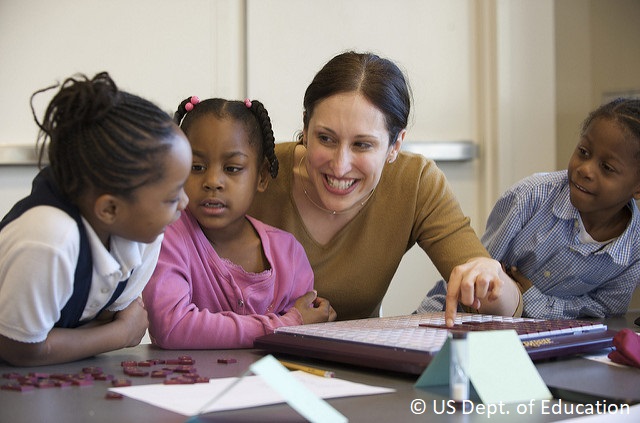By J. Douglas Willms, President of The Learning Bar Inc.
The educational prosperity framework that I introduced in a recent blog provides an essential structure for understanding the holistic and cumulative ways that children develop, learn and thrive. The benefits of the framework are hardly theoretical: they provide an important and practical guide for ways that monitoring data can—and should—be used to create smarter and more effective policies to help young people thrive.
It’s time to rethink our policy model until now, for no other reason than the less-than-impressive stagnation of global reading scores over the last 15 years. The educational prosperity framework advocates for reliance on monitoring data, as well as a frequent—and early—collection of indicators. These can be used to target policies at the local and national level that bring us closer towards the global education goal (SDG 4). We need to move away from a cause-and-effect model that tries to attribute outcomes to a specific intervention and instead recognize that multiple, nonlinear events lead to change. As education practitioners from around the world meet next week in Hamburg for the Global Alliance to Monitor Learning (GAML), it is critical to focus on the link between the smart use of data and policies that provide an opportunity for all.
Last week, we focused on the cumulative nature of learning and the ways that family, community, and institutional factors provide a foundation for success. I detailed the framework in Learning Divides: Using Data to Inform Educational Policy, which was published by the UNESCO Institute for Statistics (UIS). In this blog, we’ll take a close look at how the educational prosperity framework can be used for education policy, with a keen understanding that determinants such as poverty, gender, and geography are a core part of the puzzle. By using granular data about these factors, we can ask better questions and focus on the populations that are vulnerable and falling behind. At every stage, we need to be focusing on critical metrics to strengthen the learning foundations of every child.
How to better understand student performance

To ensure support for the most vulnerable, the educational prosperity model differentiates between equality and equity—two terms that are often used interchangeably but shouldn’t be. Equality provides information about the degree to which different subgroups, such as gender or disability, differ in achieving “prosperity outcomes” such as academic achievement. Equality is straightforward to measure: the difference between girls and boys in their average reading scores, for example, or differences among socioeconomic groups in their health are indicators of equality.
Equity is concerned with fairness: Are the differences among sub-populations in their access to school resources that effect reading outcomes just? Equity can be challenging to measure, but these two concepts are critical to creating better policies. While equality may measure the extent of the problem, measures of equity call for policies that address the problem.
These distinctions are critical because equality and equity for specific student sub-populations help us better understand student performance. At various stages throughout the life cycle, we need policies to ensure equity in the way that resources are distributed. Certain segments of the population may disproportionately drop out or fall behind as they proceed through school—and a commitment to equity demands strategies that address that gap.
The prosperity framework ensures that we focus on ways to strengthen the foundations for success at every level so that we are forging a more equitable education system. It also asks important questions: will a particular strategy – like reducing class size in a jurisdiction—improve outcomes for all youth, regardless of their socioeconomic status, or just those who need extra support?
Instead of just determining reading scores for poor children, monitoring data can also help us track their attendance rates. That information is critical if we are to also create policies that are based on realistic, measurable goals for improving student outcomes and reducing inequalities.
Data on the transition from learning-to-read to reading-to-learn
All stages of the framework are important, but two deserve particular focus as they are essential to building literacy skills. The first is the entry to early primary school, around age 6, when children are introduced to a formal classroom curriculum. The second is from early primary to late primary, as it involves the transition from learning-to-read to reading-to-learn. We need to collect data early and often—ideally every year—to catch children during these transitions before they fall through the cracks. Children already have vast discrepancies in their skills, even before they begin formal schooling. Monitoring needs to focus on the early years of primary school, when children develop the literacy skills that will be critical for their long-term success. Data on a small set of foundational factors such as quality instruction and learning time can then be used to assess equity and set goals for education improvements.
The framework also ensures that stakeholders maintain a constant focus on building the “foundations for success.” Often, administrators have ‘pet projects’, which may be based on good intentions. But by relying on the framework, we can maintain the focus on policies and programmes that support the foundations required for all children to thrive.
As we look forward, it’s time to move away from policy conversations based entirely on the rank-ordering of countries and the over-reliance on false causal claims that usually stem from them. Educational prosperity provides a framework that sets a vision for system-wide improvement that students, parents, teachers, principals, and school administrators can get behind and embrace. When all of these actors come together with the single aim of building strong foundations for our young people, we will begin to see an education system that ensures equality and equity for all children—and gives them the tools to thrive.
Leave a comment